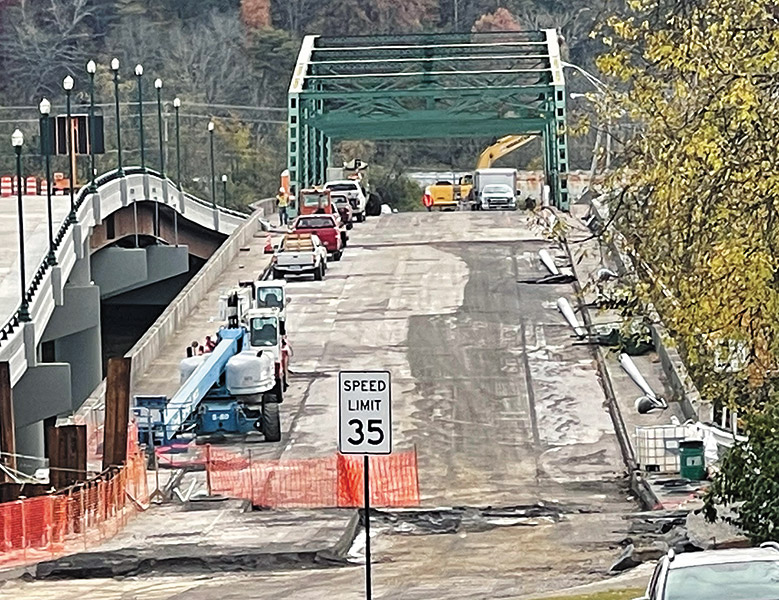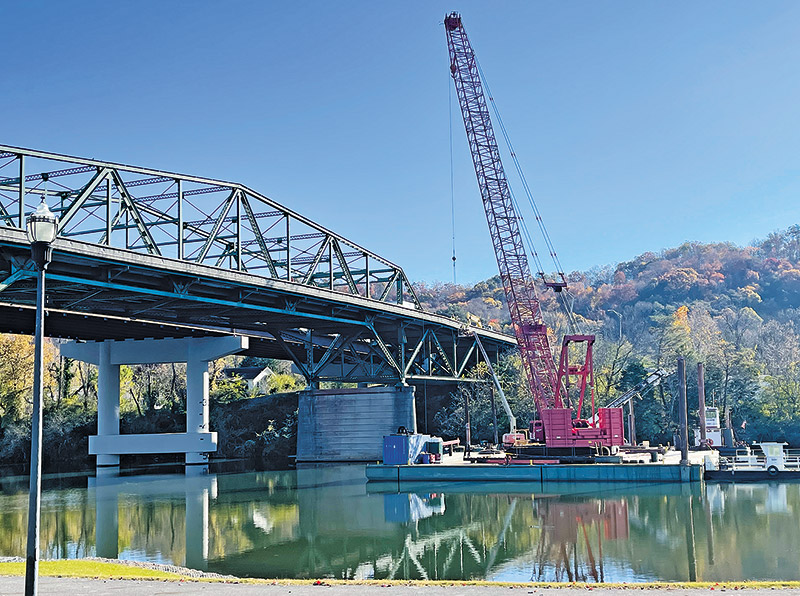Old (Lewallen) bridge is coming down
Crews have already begun work to remove the old Lewallen Bridge over the Clinch River in Clinton, with a barge and cranes set up to help with the dismantling of the steel structure.
Steel cross supports at the top of the superstructure were removed just after the new bridge was dedicated in a ceremony on Nov. 1, and work has since begun to take up the bridge’s asphalt driving surface.
Meanwhile, the remaining lanes of the new bridge are now expected to be opened to traffic about Dec. 15, which should alleviate some of the traffic jams motorists have experienced since the new bridge was partially opened in mid-October.
On Monday morning, one crew was at work along the side of the bridge hanging over the edge in a steel basket, after being lifted into place by a crane.
There has been no official word yet on when the main overhead structure of the bridge will be taken down, but city officials did say earlier that the removal work would begin almost immediately after the new bridge opened, which occurred on Tuesday, Oct. 12.
A ribbon-cutting ceremony was held on the old bridge to signify the official opening of the new span, with state and local officials participating.
While the new bridge has been partially opened to traffic in both directions, work continues on additional traffic lanes, sidewalks and bike lanes.
The old bridge has been a Clinton landmark since it opened in 1938.
Lynn Murphy, the city of Clinton’s liaison with the Tennessee Department of Transportation on the bridge construction project, provided this update Tuesday morning on the plans for removal of the old bridge and completion of the new bridge.
“The sequence for demolition is as follows:
“Remove the asphalt road surface by grinding down to the concrete deck (completed).
“Follow an engineering plan for the removal of steel, so the structural integrity is maintained throughout the process.
“Remove the concrete sidewalks and concrete parapet walls by using a large diameter concrete saw blade to cut sections (varying from 8 to 16 feet long) which are hoisting by a crane. This is a time consuming process. The concrete saw uses water to keep the blade cool, and all of the concrete dust/water slurry runoff must be contained by using a large wet vacuum system.
“Additionally, a barge covered with wood mulch is parked beneath the worksite to catch any runoff that escapes, avoiding any concrete dust slurry from dripping into the river.
“The large concrete pieces (some weighing 10,000 pounds) are pulverized with a hydraulic rock hammer device, and the debris is hauled away.
“The concrete deck floor is removed by sawing it in manageable size sections, which are hoisted by a crane, pulverized, and then hauled away.
“Once all concrete is removed, steel removal begins. Large sections of steel will be cut free using handheld oxygen-acetylene cutting torches. A barge mounted crane will hoist the large sections, then lower them to an empty barge.
“Here the larger sections will be cut into smaller pieces, and then transferred to trucks for removal. The large beams will be retained for future use and the smaller pieces will be recycled as scrap iron. All steel belongs to [the bridge contractor Blalock Construction], by contract.
“When all the bridge steel is removed, the two concrete piers will be removed from the river by sawing them off a few feet above the water surface level. The remaining concrete pier sections in the water will be drilled vertically and then broken apart using low-level explosive charges. Once detonated, any concrete and reinforcement steel in the water will be removed using a clamshell bucket attached to a crane cable.”
As for the final work and full opening of the new Lewallen Bridge, Murphy said:
“A separate construction crew is working to complete the installation of stormwater drainage pipe. Drain-pipe excavation on the south end of the project encountered solid rock, which required drilling and blasting. This portion of the drainage work should be finished [Tuesday], and the crew will move to the north end.
“Once stormwater drainage is complete, this same crew will begin installing concrete curb and gutter and concrete sidewalks. The new concrete work will connect to the southbound ends of the new bridge and continue to the ends of the project.
“Underground conduit for the remaining streetlights (five on the south end and two on the north end) and the river navigation lights must be buried, then wiring installed.
“The top layer of asphalt can then be installed, and new pavement markings will be painted, using the full width of the bridge. This will return the original turn lane configuration for northbound traffic (two lefts, two straight, one right) along with an eight-foot-wide center dividing buffer, and a bike lane in each direction.”
As for work around the bridge area, Murphy said:
“I do not have an estimate for the time required for demolition, or for the pending construction of the storm water drainage along Riverside Drive, building the new section of Riverside Drive, the new replacement section of the Lakefront Park walking trail, and the replacement boat dock beside the launch ramp.
“Then, demobilization for the cranes, barges, and equipment must take place before final clean up.”
During the Nov. 1 ceremony, Steve Borden, assistant chief engineer/regional director for the Tennessee Department of Transportation, gave some history of the Green Bridge and information about its replacement.
Borden said work on the new bridge began in September 2018, and that the contractor for the $27.6 million dollar project is Charles Blalock and Sons, Inc. of Sevierville.
According to the state Transportation Department, the “existing steel truss bridge was replaced by a webbed-steel girder [bridge] utilizing drilled shaft foundations.”
“Drivers will benefit from new traffic signals, improved signage, striping, and raised pavement markers that were included in this project,” Borden said. “The roadway portion of the bridge widened lanes from nine feet to 11 feet, and added two six-foot bike lanes.”



